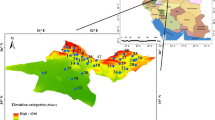Abstract
AMSR-E derived vegetation water content (VWC) at predawn (01:30 LST) and afternoon (13:30 LST) were found to have differences relating to rainfall patterns (wet spell/dry spell) over the rainfed region during late kharif season (August–October). A new index called Normalized Diurnal Difference Vegetation Water Content (nddVWC), i.e., diurnal difference of VWC per unit leaf area index (LAI) was conceptualized to assess the spatiotemporal variations of crop water stress. The nddVWC was found to be significantly (p = 0.05) correlated with rainfall particularly at 3 days time lag. It is also found to have significant correlation with Drought Severity Index (DSI). Irrigated rice crop was used as a benchmark to characterize nddVWC to represent different intensity of crop water stress (no stress ≤0.4, moderate stress >0.4 to ≤0.8, high stress >0.8). Inter-year comparative analysis of temporal variations of nddVWC was performed to assess its sensitivity in characterizing the normal and sub-normal years in term of the intensity and the persistence of crop water stress. Persistent high/moderate stress condition was observed over Vidarbha meteorological subdivision during 2009 (drought year), whereas no stress condition was prevailing during 2005 (normal year), and the year 2008 showed an intermediate condition. The spatiotemporal patterns of nddVWC could capture the progression of crop water stress condition at regional level. The proposed index has potential to monitor crop water stress in the areas otherwise considered to be too densely vegetated for conventional soil moisture retrieval.











Similar content being viewed by others
References
Ackley WB (1954) Seasonal and diurnal changes in the water contents and water deficit of Bartlett pear leaves. Plant Physiol 29(5):445–448
Bolten JD, Lakshmi V (2009) An evaluation of soil moisture retrievals using aircraft and satellite passive microwave observations during SMEX02. J Remote Sens Soc Jpn 29(1):293–300
Chakraborty A, Sesha Sai MVR (2014) Diurnal difference vegetation water content (ddVWC) of advance microwave scanning radiometer-earth observing system (AMSR-E) for assessment of crop water stress at regional level. Int Arch Photogramm Remote Sens Spat Inf Sci 40(8):21–26
Chakraborty A, Seshasai MVR, Murthy CS, Roy PS, Behera G (2012) Assessment of area favourable for crop sowing using AMSR-E derived soil moisture index. Int J Appl Earth Observ Geoinf 18:537–547
Chakraborty A, Seshasai MVR, Murthy CS, Rao SVCK (2013) Assessing early season drought condition using AMSR-E soil moisture product. Geomat Nat Hazards Risk 4(2):164–186
Cowan IR (1965) Transport of water in the soil plant atmosphere system. J Appl Ecol 2:221–239
Friesen JC, Steele-Dunne SC, van de Giesen N (2012) Diurnal differences in global ERS backscatter. IEEE Trans Geosci Remote Sens 50(7):2595–2602
Garcia-Orellana Y, Ortuno MF, Conejero W, Ruiz-Sanchez MC (2013) Diurnal variations in water relations of deficit irrigated lemon trees during fruit growth period. Span J Agric Res 11(1):137–145
Hong S, Lakshmi V, Small EE (2007) Relationship between vegetation biophysical properties and surface temperature using multisensor satellite data. J Clim 20:5593–5606
Jarvis PG (1976) The interpretation of the variations in leaf water potential and stomatal conductance found in canopies in the field. Philos Trans R Soc Lond B 273:593–610
Jönsson P, Eklundh L (2002) Seasonality extraction by function fitting to time-series of satellite sensor data. IEEE Trans Geosci Remote Sens 40(8):1824–1832
Jönsson P, Eklundh L (2004) TIMESAT—a program for analyzing timeseries of satellite sensor data. Comput Geosci 30(8):833–845
Klepper B (1968) Diurnal pattern of water potential in woody plants. Plant Physiol 43:1931–1934
Kozlowski TT (1968) Diurnal changes in the diameter of fruit and tree stems of Montmorency cherry. J Hortic Sci Biotechnol 43(1):1–16
Marigo G, Peltier JP (1996) Analysis of the diurnal change in osmotic potential in leaves of Fraxinus excelsior L. J Exp Bot 47(299):763–769
Mu Q, Zhao M, Kimball JS, McDowell NG, Running S (2013) A remotely sensed global terrestrial drought severity index. Bull Am Meteorol Soc 94(1):83–98
Njoku EG, Chan T (2006) Vegetation and surface roughness effects on AMSR-E land observations. Remote Sens Environ 100(2):190–199
Njoku EG, Entekhabi D (1996) Passive microwave remote sensing of soil moisture. J Hydrol 184:101–129
Njoku EG, Li L (1999) Retrieval of land surface parameters using passive microwave measurements at 6-18 GHz. IEEE Trans Geosci Remote Sens 37:79–93
Njoku EG, Jackson T, Lakshmi V, Chan T, Nghiem S (2003) Soil moisture retrieval from AMSR-E. IEEE Trans Geosci Remote Sens 41:215–229
Rajeevan M, Bhate J (2009) A high resolution daily gridded rainfall dataset (1971–2005) for mesoscale meteorological studies. Curr Sci 96(4):558–562
Schroeder CA, Wieland PA (1956) Diurnal fluctuation in size in various parts of the avocado tree and fruit. Proc Am Soc Hortic Sci 68:253–258
Steele-Dunne SC, Friesen J, van de Giesen N (2012) Using diurnal variation in backscatter to detect vegetation water stress. IEEE Trans Geosci Remote Sens 50(7):2618–2629
Zhu Z, Bi J, Pan Y, Ganguly S, Anav A, Xu L, Samanta A, Piao S, Nemani RR, Myneni RB (2013) Global data sets of vegetation leaf area index (LAI) 3 g and fraction of photosynthetically active radiation (FPAR) 3 g derived from global inventory modeling and mapping studies (GIMMS) Normalized Difference Vegetation Index (NDVI3 g) for the period 1981 to 2011. Remote Sens 5:927–948
Acknowledgments
NSIDC is duly acknowledged for providing AMSR-E land surface product. Daily gridded rainfall data are provided by IMD. The LAI3 g product is downloaded from ftp://crsftp.bu.edu/cliveg/. The TIMESAT software is available online in http://www.nateko.lu.se/personal/Lags.Eklundh/TIMESAT/timesat. The drought severity index is obtained from ftp://ntsg.umt.edu/pub/MODIS/Mirror/DSI. Authors are grateful to anonymous reviewers and editor for their valuable suggestions.
Author information
Authors and Affiliations
Corresponding author
Rights and permissions
About this article
Cite this article
Chakraborty, A., Seshasai, M.V.R. & Dadhwal, V.K. Assessing crop water stress during late kharif season using Normalized Diurnal Difference Vegetation Water Content (nddVWC) of Advanced Microwave Scanning Radiometer–Earth Observing System (AMSR-E). Nat Hazards 84, 533–549 (2016). https://doi.org/10.1007/s11069-016-2438-2
Received:
Accepted:
Published:
Issue Date:
DOI: https://doi.org/10.1007/s11069-016-2438-2




